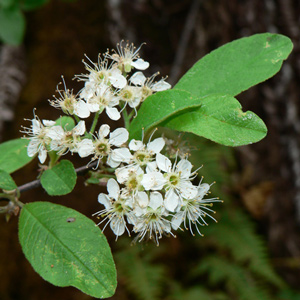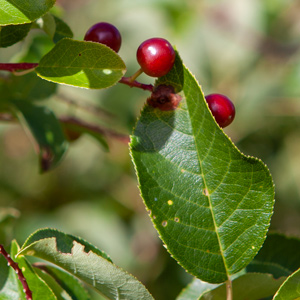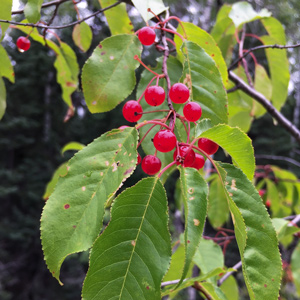Centuries before the Lewis and Clark Expedition, the ripening of the wild cherries was a season indicator for the Yanktons, Omahas, Pawnees, and Poncas.[1]Melvin R. Gilmore, “Uses of Plants by the Indians of the Missouri River Region,” (Smithsonian Institution—Bureau of American Ethnology Annual Report, Number 33, 1919), … Continue reading Many Native Nations named a moon month-cycle designating when wild cherries turned black:
- Assiniboine: capasapsaba, meaning black cherries, August
- Lakota: canpasapa wi, when the chokecherries are black, July
- Sioux: cherries turn black, August[2]“Native American Moons,” Spanel Planetarium, Western Washington University, www.wwu.edu/astro101/indianmoons.shtml accessed 24 October 2022.
Ethnobotanist Daniel Moerman, in Native American Ethnobotany, lists wild cherries as having the greatest number of uses of all plants except for Thuja plicata, western redcedar and Achillea millefolium, common yarrow. As a drug, its use ranks fifth and as a food, no other plant has more recorded uses.[3]Moerman, 11–16.
Comparative Ranges of Wild Cherries Encountered
Source: USGS Geosciences and Environmental Change Science Center: “Digital Representations of Tree Species Range Maps from Atlas of United States trees downloaded from en.wikipedia.org/wiki/Prunus_emarginata, en.wikipedia.org/wiki/Prunus_virginiana, en.wikipedia.org/wiki/Prunus_pensylvanica, and en.wikipedia.org/wiki/Prunus_serotina.
As the expedition moved across the Northern American continent, Lewis took particular notice of the changes he saw in the cherries. As they climbed the Missouri, the common chokecherry, P. virginiana var virginiana, began displacing the black cherry, P. serotina, of the east. Clark and other journalists mention the different species in June 1804, but Lewis would not describe it until May 1805 at the western extent of that variety. In present-day Montana, the black chokecherry, Prunus virginiana var. melanocarpa is the dominate variety of the common chokecherry. It was below the Falls of the Missouri that Lewis made a stomach medicine from a decoction of black chokecherry bark.
Among the Chinookan and Salishan homelands, P. emarginata, bitter cherry, is found. While at Long Camp in spring 1806, Lewis preserved a specimen and wrote a detailed botanical description of this new-to-science species. He did the same for the black chokecherry, a new-to-science variety.
Later on the return journey, laying prostrate and unable to sit or stand after taking an accidental bullet across the buttocks, he concluded his last known journal for the trip with a description of yet another wild cherry, P. pensylvanica, the pin cherry.
For a deeper dive into the Lewis and Clark Expedition’s encounters with wild cherries, see these articles:
Bitter Cherry
Prunus emarginata
by Kristopher K. Townsend
Lewis collected a specimen of bitter cherry, Prunus emarginata, while at Long Camp on 29 May 1806 and described it on 7 June 1806. He wrote that “the natives count it a good fruit”.
Black Chokecherry
Prunus virginiana var. melanocarpa
by Kristopher K. Townsend
This variety of the common chokecherry gave Lewis his decoction of simples and was the subject of his botanical scrutiny.
Common Chokecherry
Prunus virginiana
by Kristopher K. Townsend
As they traveled up the Missouri in the summer of 1804, the journalists took note of a wild cherry different than the wild cherry of their homes. It was the common chokecherry, which grew on bushes instead of trees.
Pin Cherry
Prunus pensylvanica
by Kristopher K. Townsend
Before signing off in his last journal entry, Lewis had to botanize one last time. He concludes with an accurate description of the pin cherry, Prunus pensylvanica.
Notes
| ↑1 | Melvin R. Gilmore, “Uses of Plants by the Indians of the Missouri River Region,” (Smithsonian Institution—Bureau of American Ethnology Annual Report, Number 33, 1919), archive.org/details/usesofplantsbyin00gilm; Daniel E. Moerman, Native American Ethnobotany (Portland, Oregon: Timber Press, 1988), 448; Stephen R. Jones and Ruth Carol Cushman, The North American Prairie (Boston: Houghton Mifflin Company, 2004), 353. |
|---|---|
| ↑2 | “Native American Moons,” Spanel Planetarium, Western Washington University, www.wwu.edu/astro101/indianmoons.shtml accessed 24 October 2022. |
| ↑3 | Moerman, 11–16. |
Experience the Lewis and Clark Trail
The Lewis and Clark Trail Experience—our sister site at lewisandclark.travel—connects the world to people and places on the Lewis and Clark Trail.
Discover More
- The Lewis and Clark Expedition: Day by Day by Gary E. Moulton (University of Nebraska Press, 2018). The story in prose, 14 May 1804–23 September 1806.
- The Lewis and Clark Journals: An American Epic of Discovery (abridged) by Gary E. Moulton (University of Nebraska Press, 2003). Selected journal excerpts, 14 May 1804–23 September 1806.
- The Lewis and Clark Journals. by Gary E. Moulton (University of Nebraska Press, 1983–2001). The complete story in 13 volumes.


